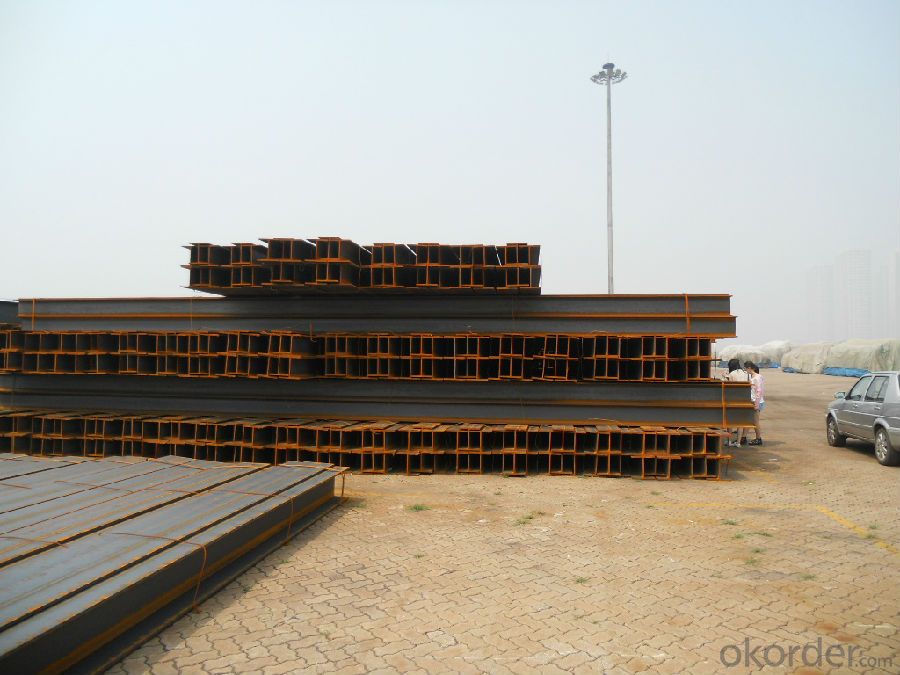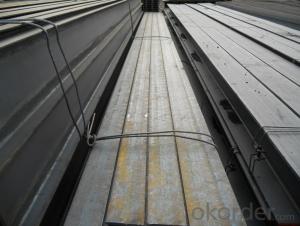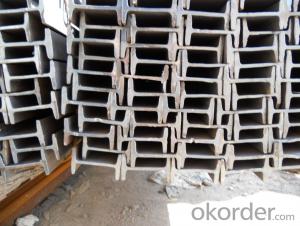Hot Rolled Steel JIS H Beam Small Size
- Loading Port:
- China Main Port
- Payment Terms:
- TT or LC
- Min Order Qty:
- -
- Supply Capability:
- -
OKorder Service Pledge
OKorder Financial Service
You Might Also Like
Product Description:
OKorder is offering high quality Hot Rolled Steel I-Beams at great prices with worldwide shipping. Our supplier is a world-class manufacturer of steel, with our products utilized the world over. OKorder annually supplies products to European, North American and Asian markets. We provide quotations within 24 hours of receiving an inquiry and guarantee competitive prices.
Product Applications:
Hot Rolled Steel I-Beams are ideal for structural applications and are widely used in the construction of buildings and bridges, and the manufacturing, petrochemical, and transportation industries.
Product Advantages:
OKorder's Steel I-Beams are durable, strong, and resist corrosion.
Main Product Features:
· Premium quality
· Prompt delivery & seaworthy packing (30 days after receiving deposit)
· Corrosion resistance
· Can be recycled and reused
· Mill test certification
· Professional Service
· Competitive pricing
Product Specifications:
Manufacture: Hot rolled
Grade: Q195 – 235
Certificates: ISO, SGS, BV, CIQ
Length: 6m – 12m, as per customer request
Packaging: Export packing, nude packing, bundled
SIZE(mm) | DIMENSION(kg/m) |
100*100 | 16.9 |
125*125 | 23.6 |
150*75 | 14 |
150*150 | 31.1 |
148*100 | 20.7 |
198*99 | 17.8 |
200*100 | 20.9 |
248*124 | 25.1 |
250*125 | 29 |
Packaging & Delivery of Hot Rolled Structural Steel H Beam
1. Packing: it is nude packed in bundles by steel wire rod
2. Bundle weight: not more than 3.5MT for bulk vessel; less than 3 MT for container load
3. Marks:
Color marking: There will be color marking on both end of the bundle for the cargo delivered by bulk vessel. That makes it easily to distinguish at the destination port.
Tag mark: there will be tag mark tied up on the bundles. The information usually including supplier logo and name, product name, made in China, shipping marks and other information request by the customer.
If loading by container the marking is not needed, but we will prepare it as customer request.
4. Transportation: the goods are delivered by truck from mill to loading port, the maximum quantity can be loaded is around 40MTs by each truck. If the order quantity cannot reach the full truck loaded, the transportation cost per ton will be little higher than full load.
5. Delivered by container or bulk vessel
FAQ:
Q1: How soon can we receive the product after purchase?
A1: Within three days of placing an order, we will begin production. The specific shipping date is dependent upon international and government factors, but is typically 7 to 10 workdays.
Q2: What makes stainless steel stainless?
A2: Stainless steel must contain at least 10.5 % chromium. It is this element that reacts with the oxygen in the air to form a complex chrome-oxide surface layer that is invisible but strong enough to prevent further oxygen from "staining" (rusting) the surface. Higher levels of chromium and the addition of other alloying elements such as nickel and molybdenum enhance this surface layer and improve the corrosion resistance of the stainless material.
Q3: Can stainless steel rust?
A3: Stainless does not "rust" as you think of regular steel rusting with a red oxide on the surface that flakes off. If you see red rust it is probably due to some iron particles that have contaminated the surface of the stainless steel and it is these iron particles that are rusting. Look at the source of the rusting and see if you can remove it from the surface.
Images:


- Q:Can steel H-beams be used in the construction of religious buildings or churches?
- Yes, steel H-beams can be used in the construction of religious buildings or churches. Steel H-beams offer several advantages for construction projects, including their strength, durability, and versatility. They provide a sturdy framework that can support the weight of the structure and withstand various weather conditions. Additionally, steel H-beams can be easily fabricated and customized to fit different architectural designs, allowing for flexibility in the construction of religious buildings or churches. Their use in construction projects has become increasingly popular due to their cost-effectiveness, sustainability, and ability to meet building codes and safety requirements. Ultimately, the decision to use steel H-beams in the construction of religious buildings or churches depends on various factors, including the architectural vision, structural requirements, and budget of the project.
- Q:How do steel H-beams perform in high wind conditions?
- Steel H-beams are highly durable and perform exceptionally well in high wind conditions. The unique design of H-beams provides them with superior strength and stability, making them ideal for withstanding strong winds. The horizontal flanges of the H-beams distribute the wind load evenly, while the vertical web resists any twisting or bending forces caused by the wind. This structural integrity ensures that the H-beams remain stable and secure even during extreme wind events. Moreover, steel H-beams have a high strength-to-weight ratio, which means they can withstand significant wind pressures without adding excessive weight to the overall structure. This advantage allows for more flexible and efficient designs, making steel H-beams a popular choice in construction projects located in areas prone to high wind conditions. Additionally, steel H-beams are highly resistant to corrosion, which further enhances their performance in high wind conditions. Unlike other building materials, such as wood or concrete, steel does not degrade or weaken when exposed to moisture or harsh weather conditions. This corrosion resistance ensures the long-term durability and structural integrity of steel H-beams, even in challenging environments. In summary, steel H-beams are designed to excel in high wind conditions. Their unique shape, strength, and resistance to corrosion make them capable of withstanding strong winds while providing stability and security to the overall structure. Therefore, steel H-beams are a reliable choice for buildings and structures in areas prone to high wind events.
- Q:Do steel H-beams require additional bracing?
- Yes, steel H-beams typically require additional bracing to provide stability and prevent buckling or lateral movement under load.
- Q:How do steel H-beams compare to I-beams in terms of strength?
- Steel H-beams and I-beams are both common structural elements used in construction, but they differ in their shape and design. In terms of strength, H-beams and I-beams have different load-bearing capacities due to their structural characteristics. H-beams, also known as wide flange beams, have a wider flange and a narrower web compared to I-beams. This design allows H-beams to support heavy loads over a wider span, making them suitable for applications that require greater strength and stability. The wider flange of H-beams provides increased resistance to bending, torsional forces, and shear stress, making them well-suited for structures such as bridges, buildings, and heavy machinery. On the other hand, I-beams, also known as universal beams or rolled steel joists, have a narrow flange and a thicker web. This particular shape allows I-beams to resist bending and deflection, making them ideal for applications that require long spans and minimal sagging. I-beams are commonly used in residential and commercial construction, as well as in the manufacturing of beams and columns. In terms of comparing the strength of H-beams and I-beams, it is important to consider the specific dimensions, material properties, and loading conditions. Generally, H-beams have a higher load-bearing capacity compared to I-beams due to their wider flange and greater resistance to various types of forces. However, it is crucial to consult structural engineers or reference load tables to determine the appropriate beam type and size for a specific construction project. In conclusion, while both steel H-beams and I-beams are strong structural elements, H-beams generally have a higher load-bearing capacity due to their wider flange design. However, the choice between H-beams and I-beams depends on the specific requirements and loading conditions of the construction project.
- Q:What are the fire resistance ratings for steel H-beams?
- The fire resistance ratings for steel H-beams depend on various factors such as the dimensions of the beam, the type of fire protection applied, and the specific building codes and regulations in place. Generally, steel H-beams have inherent fire-resistant properties due to their high melting point and structural stability. However, to enhance their fire resistance, additional fireproofing materials such as intumescent coatings or fire-resistant insulations can be applied. These measures can significantly increase the fire resistance ratings of steel H-beams, allowing them to withstand fire exposure for extended periods, typically ranging from 30 minutes to several hours.
- Q:What are the limitations of steel H-beams?
- There are several limitations associated with steel H-beams. Firstly, steel H-beams have a relatively high cost compared to other building materials such as wood or concrete. This cost can be a limiting factor for smaller-scale construction projects or those with budget constraints. Secondly, steel H-beams are heavy and require specialized equipment for transportation and installation. This can add complexity and cost to a construction project, particularly if access to the site is challenging or limited. Another limitation is that steel H-beams are susceptible to corrosion, especially in environments with high humidity or exposure to saltwater. Over time, this corrosion can weaken the structural integrity of the beams, leading to potential safety hazards and maintenance requirements. Additionally, steel H-beams have limited design flexibility compared to other materials. They are typically straight and inflexible, making it more challenging to incorporate complex architectural or structural designs. Lastly, steel H-beams have limited fire resistance. Steel is a good conductor of heat, and in the event of a fire, the H-beams can quickly transfer heat throughout the structure, potentially compromising its stability. Fire protection measures such as fireproof coatings or additional fire-resistant materials may be necessary to mitigate this limitation. Overall, while steel H-beams offer many advantages in terms of strength and durability, their limitations in terms of cost, weight, corrosion susceptibility, design flexibility, and fire resistance should be carefully considered when selecting the appropriate building material for a construction project.
- Q:Are steel H-beams susceptible to warping or bending?
- Steel H-beams are designed to withstand heavy loads and are generally resistant to warping or bending under normal circumstances. However, extreme forces or improper installation techniques can potentially cause some degree of warping or bending.
- Q:How do steel H-beams perform in extreme weather conditions, such as high winds or heavy snow?
- Steel H-beams are known for their superior strength and durability, which make them highly reliable in extreme weather conditions such as high winds or heavy snow. Their unique shape and structural design allow them to effectively resist bending, twisting, and buckling forces, making them ideal for withstanding the challenges posed by severe weather. In high winds, steel H-beams perform exceptionally well due to their high stiffness and resistance to wind loads. The H-shaped cross-section of the beam provides increased stability and prevents it from deflecting or getting damaged even under strong gusts. This characteristic makes H-beams a popular choice in structures located in hurricane-prone areas or regions with frequent high winds. Similarly, steel H-beams are also well-suited to handle heavy snow loads. Their robust construction and high load-bearing capacity make them capable of supporting the weight of accumulated snow without experiencing any significant deformation or failure. This is particularly important in areas where snowstorms are common, as the H-beams ensure the structural integrity of buildings, bridges, or other infrastructures under these extreme conditions. Moreover, steel H-beams are not only resistant to wind and snow loads but also highly durable against corrosion and rust. This is due to the protective coatings and treatments applied to the steel during the manufacturing process. These coatings help prevent the formation of rust and ensure the longevity of the beams, even in harsh weather environments. Overall, steel H-beams have a proven track record of performing exceptionally well in extreme weather conditions like high winds or heavy snow. Their strength, stability, and resistance to both external forces and corrosion make them a reliable choice for various construction projects, providing peace of mind to engineers, architects, and property owners alike.
- Q:How do steel H-beams perform in wind-prone areas?
- Steel H-beams are highly durable and strong structural elements that are commonly used in construction, especially in wind-prone areas. These beams are designed to withstand various forces, including wind loads, making them an excellent choice for buildings and structures in regions prone to strong winds. The shape and design of H-beams allow for superior load-bearing capacity and resistance to bending and twisting. This makes them highly effective in withstanding the forces imposed by high winds. The H shape of the beam provides a large surface area, which helps distribute the wind load evenly across the structure, reducing the risk of failure. Additionally, steel is known for its high strength-to-weight ratio, making H-beams a lightweight yet robust choice for wind-prone areas. This ensures that the structure can withstand the dynamic and fluctuating forces exerted by strong winds without compromising its overall integrity. Furthermore, steel H-beams have excellent resistance to corrosion, which is crucial in areas with high humidity or exposure to saltwater, as these conditions can accelerate the deterioration of other building materials. The corrosion resistance of steel H-beams ensures their longevity and structural integrity in wind-prone regions, minimizing the need for frequent maintenance or replacement. In summary, steel H-beams perform exceptionally well in wind-prone areas due to their high strength, load-bearing capacity, resistance to bending and twisting, and corrosion resistance. Their ability to withstand wind loads and their durability make them a reliable choice for constructing buildings and structures in regions with strong winds.
- Q:Can steel H-beams be used in historical or heritage building restoration?
- Yes, steel H-beams can be used in historical or heritage building restoration. They provide structural support and can be designed to blend in with the existing architectural elements. However, it is important to consult with experts and follow preservation guidelines to ensure minimal impact on the historical integrity of the building.
1. Manufacturer Overview |
|
|---|---|
| Location | |
| Year Established | |
| Annual Output Value | |
| Main Markets | |
| Company Certifications | |
2. Manufacturer Certificates |
|
|---|---|
| a) Certification Name | |
| Range | |
| Reference | |
| Validity Period | |
3. Manufacturer Capability |
|
|---|---|
| a)Trade Capacity | |
| Nearest Port | |
| Export Percentage | |
| No.of Employees in Trade Department | |
| Language Spoken: | |
| b)Factory Information | |
| Factory Size: | |
| No. of Production Lines | |
| Contract Manufacturing | |
| Product Price Range | |
Send your message to us
Hot Rolled Steel JIS H Beam Small Size
- Loading Port:
- China Main Port
- Payment Terms:
- TT or LC
- Min Order Qty:
- -
- Supply Capability:
- -
OKorder Service Pledge
OKorder Financial Service
Similar products
New products
Hot products
Related keywords



























